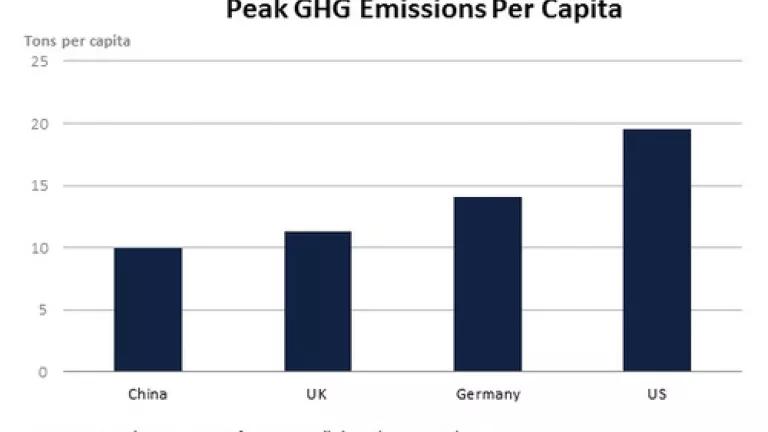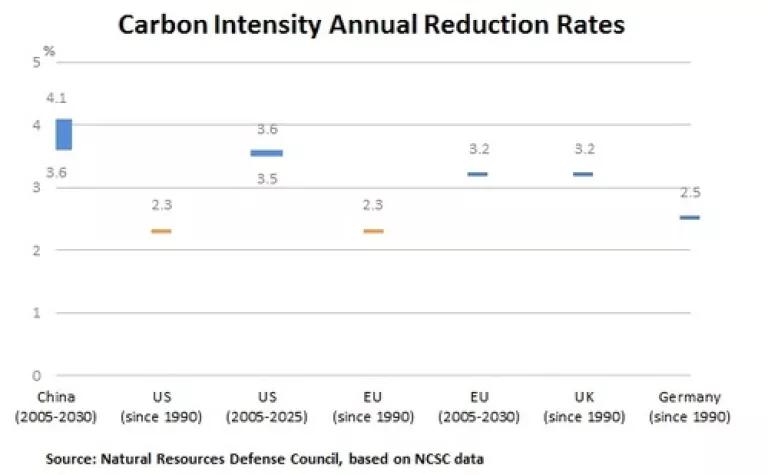
As mentioned in a post on Carbon Pulse, China's climate pledge will require the country to make very significant changes to its emissions trajectory - including adding non-fossil power equivalent to the entire U.S. power generating capacity by 2030. When you compare China's growth trajectory against that of developed countries, how does it compare?
Li Junfeng, Director General of the National Center of Climate Change Strategy Research and Deputy Director of the Energy Research Institute at China's National Development and Reform Commission, has provided a helpful comparison of China's climate pledge and that of leading developed countries. He concludes that China is making significant contributions comparable to that of developed countries, based on a number of indicators we'll discuss below.
Comparing peak years, China's emissions would peak at a much lower GDP per capita than that of developed countries
China committed to peak its emission by 2030, when its GDP per capita will be at about $10,000 in 2005 dollars. The United States peaked when its GDP per capita was at about $40,000. The EU peaked when its GDP per capita was at about $20,000. While some other developed countries still haven't peaked at $50,000.
Comparing the peak value per capita, China has a lower emissions per capita
Based on current projections, China's emissions per capita when it peaks will be no more than 10 tons GHG per capita. The U.S. peaked at 19.5 tons GHG per capita, while Germany peaked at 14.1 tons GHG per capita and the UK peaked at 11.3 tons GHG per capita.
Comparing carbon intensity reductions, China will achieve a greater annual reduction rate of carbon intensity than most developed countries
To meet the commitment of reducing carbon intensity by 60 percent - 65 percent in 2030, China would have to keep a 3.6 percent-4.1 percent annual reduction rate from 2005 to 2030. The U.S. rate since 1990 was 2.3 percent, and from 2005 to 2025 it would need to average 3.5 percent to 3.6 percent to reach the 26 to 28 percent total emissions reduction target as laid out in the U.S. climate pledge. The EU reduction rate since 1990 was also 2.3 percent, and the rate required to meet the EU goal of a 40 percent total emissions reduction in 2030 from 1990 levels would be 3.2 percent. Similarly, the UK's intensity reduction since 1990 is 3 percent annually, and Germany's is 2.5 percent.

To increase non-fossil fuel energy production, China will need to add much greater capacity in absolute terms than most developed nations
To meet its climate pledge, China would need increase its ratio of non-fossil energy from 7.4 percent to 20 percent from 2005-2030, which means it needs non-fossil fuel energy to reach 1.2 billion tons of coal equivalent out of a total energy consumption of 6 billion tons of coal equivalent. That would require an increase in non-fossil fuel energy of 1 billion tons of coal equivalent relative to 2005. By comparison, the EU will only need to increase its non-fossil fuel energy by 0.4 billion tons to reach its 27 percent renewable goal.
Achieving a global emissions peak in 2020-2030
According to Li Junfeng, if China's commitment to peak before 2030 can encourage developed countries to raise their ambitions as well, this could be a major stepping stone to peaking global emissions sometime between 2020 and 2030. Such a peak could help get the world on track to reducing emissions by 40 percent by 2030 from 2010 levels, which is what the Intergovernmental Panel on Climate Change has recommended to keep temperature rise below 2 degrees Celsius.
As my colleague Jake Schmidt noted, China's INDC demonstrates that is already headed for an earlier and lower emissions peak than many expected just a few short years ago.
This blog was coauthored by NRDC International Climate Advocate Han Chen and NRDC Intern Wusi Fan.
